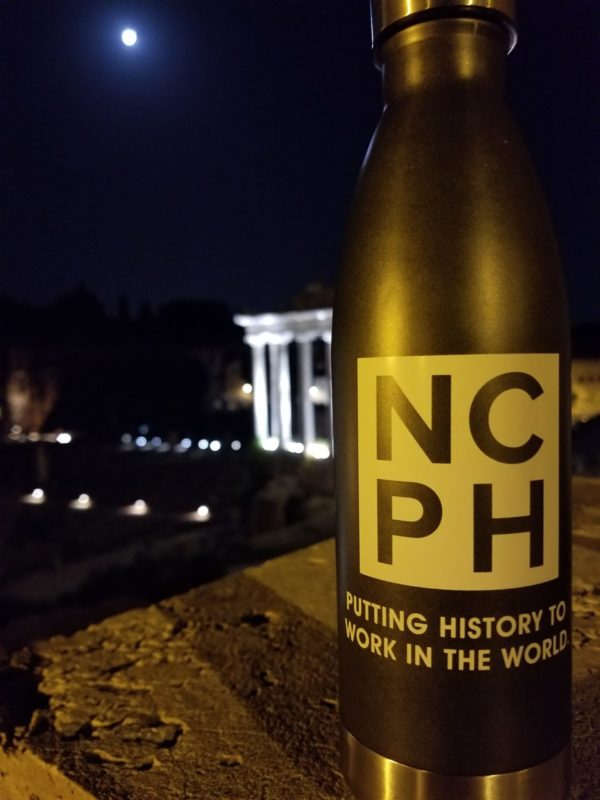A Greener Conference in the Peach State
10 March 2020 – Philip Levy, Carolyn Barske Crawford and Alena Pirok
Editors’ Note: This is the second of two posts by leaders of the National Council on Public History (NCPH)’s Committee on Environmental Sustainability. You can get involved by attending the Green Meetings Working Group session on Saturday, March 21, at the annual meeting in Atlanta, Georgia. The first post in this series can be found here.
Personal preparation for the NCPH annual meeting provides a chance to explore some green practices that can help reduce our individual and collective carbon footprints. The NCPH Committee on Environmental Sustainability (CoES) has spent the last year preparing our Green Meetings report on conference sustainability and thinking about the way NCPH and its members can adopt greener, more sustainable, practices. Part of that work has entailed reviewing a large body of literature on how to be a bit more green when away from home. We have assembled some of the best suggestions and added a few of our own. These are just recommendations, and we are fully aware that not everyone is in a position to change how they travel and attend conferences. Differing abilities and stations in life will mean that works for one person may not work for another. Nevertheless, we hope that everyone will find something of value in this small list.

The NCPH water bottle from a few years ago makes a good traveling companion. Here it is in Rome. Photo Credit: Priya Chhaya
Packing/Preparation
- Avoid creating waste by bringing your own coffee tumbler and water bottle. Display your reusable container with pride on the table during your presentation!
- Bring an extra reusable grocery or tote bag in your luggage so that you won’t need a plastic bag should you go shopping.
Travel
As we discussed in our earlier post, the number one cause of travel-related carbon release is air travel. Airplanes are environmental nightmares. As a society, though, we do not yet have reliable or manageable reduced carbon or carbon neutral transportation alternatives. But that does not mean that we are left to sit passively on the sidelines and await a solution. The key to green travel in the US is trying to take advantage of systems that are already in place like public transportation.
- If you have not yet finalized your travel plans, consider taking the train to Atlanta. The Amtrak pulls in at Peachtree Station, 4 miles from the hotel.
- Once you arrive, there are public transportation options to get you to the hotel and around the city, a more complete list is included in the Getting To (and Around) Atlanta section of the conference program.
- If you are coming from the airport, hop aboard MARTA. The gold and red lines will take you to the Westin Peachtree Plaza.
- The Atlanta Street Car route makes a 12-stop loop around the city. The closest stops to the Westin are “Carnegie at Spring” and “Peachtree Center.”
At the Conference
Traditionally, conferences produce a lot of paper, but there are ways to cut down on paper use.
- Instead of collecting paper business cards and flyers, take a photo of the card or flyer.
At the Hotel
Stay conscious of the waste you make.
- Reuse your lightly used towels
- Avoid disposable dishes where possible, cutlery, stir-sticks, napkins, and cups. Many people bring their own silverware when they stay in hotels.
- Some people intentionally avoid using in-room electrical appliances like blow dryers.
In town
- Bring your own food storage containers for leftovers, thus avoiding wasteful packaging.
- For those who are able, try vegetarian and/or locally sourced options. Meat production creates a significant amount of environmental waste and pollution; use the conference as an opportunity to try something new. The Dining and Drinks section of the conference program includes a listing of vegan-and vegetarian-friendly restaurants.
Finally, if you use social media, join us in increasing awareness of this committee’s charge. As you venture out to Atlanta and during the conference itself, please use the hashtag #CaughtBeingGreen, along with other conference tags, such as #NCPH2020, to encourage individuals to adopt more green habits and help NCPH become a model of engaged environmental sustainability. If granted permission, include names, affiliations, and if applicable, presentation time and date, and session number of the person being recognized for their efforts. We hope this opens discussion and helps everyone see how manageable green practices can be. Contact Phil Levy at [email protected] for more information or a draft of the report.
See you in Atlanta!
~Carolyn Barske Crawford is the director of the Muscle Shoals National Heritage Area and an affiliated faculty member in the UNA Department of History. Dr. Barske Crawford holds a bachelor’s degree from Sewanee: The University of the South, a master’s degree from Northeastern University, and a doctorate from the University of Massachusetts, Amherst.
~Alena Pirok is an assistant professor of history at Georgia Southern University, in Savannah. Her book manuscript looks at the relationship between ghostlore and the development of Colonial Williamsburg. She is currently working on a piece about trees and historical places in Savannah, GA.
~Philip Levy is a professor of history at the University of South Florida. He is the author of Where the Cherry Tree Grew and George Washington Written Upon the Land. He is writing a book about the history and implications of urban chicken keeping. His blog is Remnantology.



